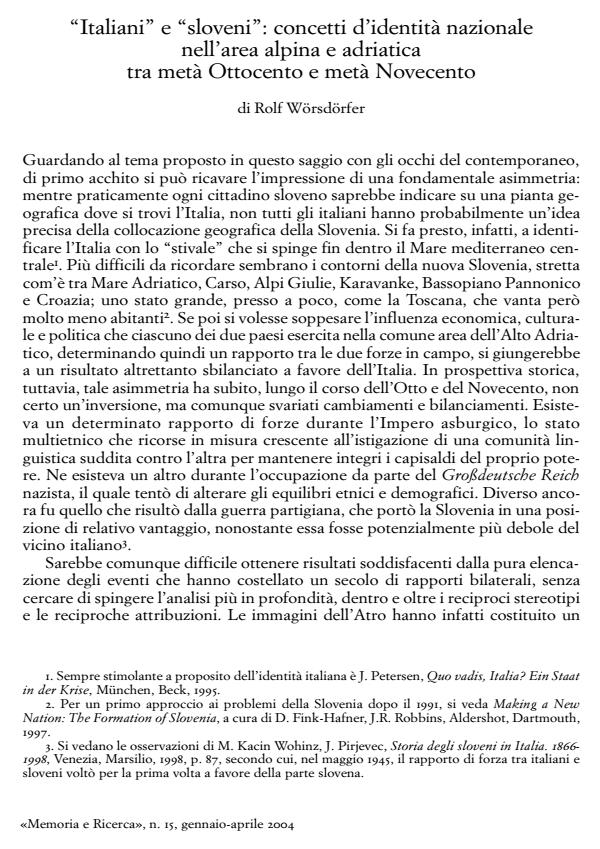Italiani e sloveni: concetti d'identità nazionale nell'area alpina e adriatica tra metà ottocento e metà novecento
Journal title MEMORIA E RICERCA
Author/s Rolf Worsdorfer
Publishing Year 2004 Issue 2004/15
Language Italian Pages 30 P. File size 144 KB
DOI
DOI is like a bar code for intellectual property: to have more infomation
click here
Below, you can see the article first page
If you want to buy this article in PDF format, you can do it, following the instructions to buy download credits

FrancoAngeli is member of Publishers International Linking Association, Inc (PILA), a not-for-profit association which run the CrossRef service enabling links to and from online scholarly content.
Since the late nineteenth century the regions along the north-eastern Adriatic Sea, characterized by a complex pattern of Italian, Slovene, Croatian and other ethnic groups, have been a major battleground of opposing national movements. During the last decades of the Dual Monarchy the German speaking element no longer presented any particular danger to smaller groups of people in the region. Angelo Vivante wrote in 1912 that the only real ethnic conflict was the one between Italians and Slaves. Relations between Italians and Slovenes were characterized by collaborations well as by rivalry and confrontation, depending on which region and which period one may examine. Although it might be difficult to know the real weight of literary imagines and national stereotypes, one may find them in a lot of occasions along the clash between Italians and Slovenes in the 19th and 20th centuries. When in 1920 in the Treaty of Rapallo the former Austrian Küstenland was accorded to Italy; structural multilingualism and spontaneous assimilation processes were in contrast to various programs of ethnic cleansing or bonifica etnica. At first, it was the fascist movement in particular which proceeded with terror directed against Slovenian organisations, parties, clubs and newspapers. The systematic denationalisation campaign of the fascist regime began in various social areas with a certain delay. The political programmes of Italian and Slovene partizan-movements provided new national identities for inhabitants of the border region who had not assumed any particular national attitude or who had suffered by fascist denationalization campaigns accepting the italianità as their only national orientation. In the period after the second World War, subsequent to the assignation of Istria, Fiume and Zara to Yugoslavia, some hundred thousand Italians abandoned their homes and left. The abandoning of the Adriatic region by one of its principal ethnic-national components must be placed in the context of a fierce clash between opposed nationalisms, of rivalry between nation-states, and of the growing importance of national-totalitarian ideologies at the level of the individual state, upon which were superimposed the new divisions of the Cold War. Although in most cases the Italian’s decision to abandon their homelands was not a direct consequence of measures of expulsion, the decision to leave must be seen as the result of specific pressures which make it possible to describe this event as an example of mass expulsion.
Rolf Worsdorfer, Italiani e sloveni: concetti d'identità nazionale nell'area alpina e adriatica tra metà ottocento e metà novecento in "MEMORIA E RICERCA " 15/2004, pp , DOI: